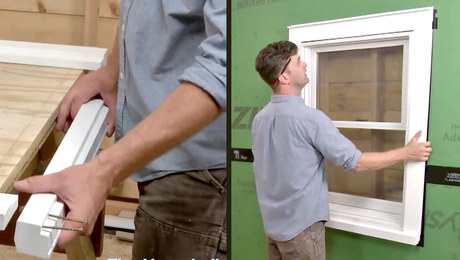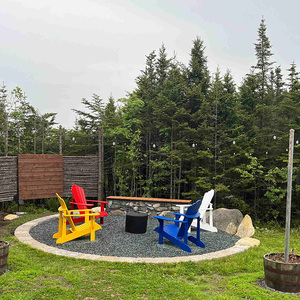*
I’m interested in hearing what people have to say about acrylic vs. oil-base paint for exterior applications, especially doors and windows.
My personal preference is for oil-base – I think it’s tougher and more weather-resistant – but I know there are folks out there who swear by acrylic latex.
Any professional painters out there?
Thanks.
Steve Holmes



















Replies
*
My personal preference is alkyd paint at least for the primer coat ........most of my work has been on older buildings and I believe alkyds perform better in that application in my part of the country though I have to admit acrylics are much improved. imho, the most important things are to buy a good brand of paint, do the prep work (wash-kill the mildew and get rid of dirt,scrape, sand, and prime) follow the directions of the paint manufacturer and you should get good results regardless if it's acrylic or alkyd.
*if you are painting new wood or if you have stripped old wood down to bare, oil base is the only way to go. i have spent the last ten years trying to get the most time out of my paint work. if you can get paid for it, use schreuder oil paints. the next best exterior primer i like is muralo x-200 linseed oil. latex paints are just fine for the finish coats. but if you can only get paid for painting over existing paint with little prep work, you are wasting your time with oil primer. just slap a coat of muralo quick tread latex on top.
*I'm not a painter. Here's whati Paint in Americapublished by the National Trust for Historic Preservation says. Latex paints are more durable than oil based paints. Quoting from the book, "Resins used in [latex] generally have much higher molecular weights than resins used [in oil]. ... Because of the inherent chamical stability of good acrylic resins and because of the high molecular weight of emulsion resins, acrylic emulsion (acrylic latex) paints offer by far the highest degree of weather resistance of any type of paint in common use today on American buildings." The author goes on to say this is not true when going over old, chalky paints. Of the three kinds of "latex" paints, he says that the 100% acrylic is the best: "The principal synthetic polymers that have been used in emulsion paints are of the acrylic, poly vinyl acetate, and styrene-butadiene classes (and combinations of these). The molecular structure of good acrylic resins renders them more resistant to oxidative degradation than styrene-butadiene and more resistant to water than poly vinyl acetates. They [acrylic] are generally considered the best class of emulsion paints for general architectural use."
*Hmmm. I'm not a painter either (except on my own house), but I've been taking an informal poll of painters I know, and without exception, they prefer oil to acrylic. They prefer the look of oil (acrylic looks flat, one said), and they prefer the brushability of oil (it flows out better). Now, these are all guys who have been painting for at least a couple of decades, and it may be a case of old dogs/no new tricks, but I'm inclined to agree with them. Thanks for all your answers, by the way, and if any of you know any painters, maybe you could ask them the question.S.
*I know some old carpenters that still drive nails by hand. They have done it this way for decades, and continue to do so today. Does this make them smarter? Better? It is just the way they do it, and the way they prefer to do it. They just don't want to change, and they don't want anybody telling them they need to change. In a fast changing world of carpentry, they are getting left behind. Painters who will only use one type of product are gonna get left behind too if they are not careful.Professional painters that I know personally have an awful time trying new things, and changing techniques. They hate acrylics because 20 years ago they tried acrylics. Todays acrylics are definitely not yesterday's acrylics. Acrylic paints are here to stay, and alkyds are on their way out (Even in the industrial applications). The EPA regs are making it harder and harder for alkyd paints to be anywhere near the quality that they once were, while acrylics are advancing every day. Alkyds have their place, and acrylics have theirs. Soon, acrylics will have ALL the places.James DuHamel
*Here's my take-Acrylics make for a harder surface with more integrity, but the molecules bonmd to each other better than to the surface they're applied to. That means there's a tendancy to form a plastic sheet like a layer of saran wrap. It can resist water better but is more prone to blistering off in sheets. This is where the bad rep of twenty years ago comes from. You can multiply that by the great number of 'painters' who don't do the prep work needed to assure a good bond.Oils let their molecules slowly cure independently while sticking themselves together. This makes it possible for them to settle and wick into the wood grain, filling and saving it. The surface may not be quite as hard and water repellent but it is more forgiving. Good prep still counts but a five percent flaw won't start a fifty percent blister. eg a slight amount of surface dust will be consolidated into the paint with oils, becoming part of the finish. Latex will treat it as a foreign body, so the final finish and longevity suffers more.We are on the coast and have high humidity so I expect that this influences painters opinions also. None hear has started to use latex for exterior work yet. The DIY's do their place in latex and proudly exclaim the thousands of dollars saved, then three years later they hire a painter to do it in oil which then lasts about 8-10 years. I do little painting myself but from what I've observed, comparing appples to apples on same kind of work and prep. the oil will last almost twice as long, especially if exposed to the extremes like a window sill where it faces the sun and rain plus reflective doubling of UV rays.
*One advantage that alkyd paints, particularly primers, may have is that it simply takes longer for the solvent to evaporate. This property means that alkyd paints have more time to soak into the upper layer of the substrate, so they may achieve a better bond than acrylics. This is particularly so when it's hot and dry, and the water comes out of the acrylic paint too fast, or when you're priming a weathered wooden surface.However, acrylic paints are generally more flexible and so stand up to subsequent changes in temperature and humidity better. The compromise to get the best of both worlds is to use an alkyd primer and an acrylic top coat(s). So say the folks at the USDA Forest Products Lab, anyway.Throw fiber-cement siding into the equation, and the siding manufacturers require acrylic paint.Andy
*Andy, sounds like good advice and dovetails well with my own theories above.
*If you are doing proper prep work, and the exterior surface (like trim, siding, etc...) is properly flashed, sealed, and water tight, then any quality exterior paint job should last at least 8 to 10 years, with many lasting 12 to 15 years. The biggest problem I see as a professional is water penetration behind the trim, siding, etc... This water penetration allows moisture to migrate through the wood. Acrylic paints allow this moisture to pass through, while alkyd paints trap the moisture between the wood and paint coating. This is where a lot of peeling occurs.As far as which has a harder surface when cured (paint does not dry, it cures), if you are using an enamel, which you should be, then both acrylic enamels and alkyd enamels have an extremely hard, long lasting surface.When dealing with bare wood, alkyd primers are your best choice. Primers are NOT the same thing as the top coat of paint, and are not used the same. Primers are sealers, and bond coats. They chemically bond themselves to the surface of the material to be painted, and then chemically bond the top coat of paint to the primer. Alkyd primers work best on bare wood because they penetrate deeper into the wood fibers, and chemically bond to them. They offer a much deeper protection. There are a vast number and types of primers, and each one has its place. Some are for high hiding of tannins and oils, some hide sap and knots. Some cover and bond with chalky surfaces.When dealing with a previously painted surface that is still sound, alkyd primers lose their advantage. They no longer penetrate deep into the wood fibers because the wood is already coated with a paint. Acrylic primers are easier to work with because they clean up with water. However, they too have a time and a place that they work best. There are acrylic primers on the market that are specifically made to cover high gloss surfaces so that no other surface prep is needed (i.e. sanding, de-glossing, etc...) and some that are specifically made for chalky surfaces. They chemically bond themselves to the chalky substance, and form a new, hard surface to be top coated.Primers usually are good for about 2 weeks. After that, they lose their ability to chemically bond with the top coat of paint. This is when you basically lose the advantage of the primer, and are no better off than if you simply top coated a surface with no primer at all.James DuHamel
*I have followed this discussion with great interest. I am not a professional but I am about to undertake a large project. Steve, I hope you don't mind if I interject another question for the professionals. The house is old and very large. There is no vapor barrier. The siding is pine clapboard nailed to sheeting. Any suggestions on the longest wearing primer, top coat combination? I will be removing all the old paint. Does the fact that it was originally painted with linseed oil base paint affect my choice of primer? I live in the upper penninsula of Michigan (hard winters, hot and humid summers). Thanks for any advicePaul Ripple
*You can make a case for oil based primers in some applications, and oil based top coats for a front door based on esthetics.I really don't know too many aplications where you can make a good case for painting a house with oil products.I'm solidy with James DuHamel on this topic and am extremely surprised to hear much discussion about it at all. Good luck Jamesjoe d
*I know a couple of the painters in the 'hood and have talked to them all on this topic at one time or another. Most recently was to the father of one of my son's little league team-mates. He told me that he's switched to a shellac-based primer for new wood and often uses an oil primer outside because it's far less labour-intensive than a full prep job in a very competitive field. Past that, he says that oils aren't what they used to be and acrylics are usually better for most applications now. I do have one painter friend who's locked in the "my father used oil paint for 50 years and I've been using it for 30 and see no reason to change" camp; but, they are becoming dinosaurs.
*Steve,There's a discussion over at http://www.thathomesite.com (URL: http://ths.gardenweb.com/forums/load/repair/msg0821265232541.html?7) (the discussion is in the "home repair" forum under the topic, "A question about exterior paint") with lots of information in it; the fellow posting really seems to know his stuff. You might also check out http://www.paintquality.com. It's the site sponsored by Rohm and Haas, who manufacture most of the acrylic and vinyl acrilic resins used in the US.
*No offense, but Nestor is an idiot. I've known Nestor for about 2 years. He is a DYI'er with no real experience. He owns a few apartments, and is basically a landlord. This is where he has gotten the sum total of his knowledge and skill - from being a landlord, and doing his own repairs. He lives in Canada, and honestly used to believe that all building codes across the U.S. were the exact same as where he lives.He is, however, a very nice guy, and tries to help anybody and everybody he can.Tell him James DuHamel said hello.James DuHamel
*when preping end cuts on siding or trim, rather than having a paint and paintbrush drying in the can, have you ever found a spray paint that would work. Don't know if any of the correct products are available but sure seems that it would be alot easier to hit the fresh end cut with a spray and then install.Victor
*James' comments about changing with the times, etc., pretty much echo my sentiments regarding this paint issue (and a lot of other things, for that matter). But...... I'll be damned if I can get latex to flow properly when doing things like trim, doors, etc. Although products like Floetrol help, they're still no substitute for a good flowing oil paint. When are the manufacturers going to come up with a solution for this problem? And, no, I don't use cheap, throw-away brushes- I happen to have a small fortune invested in brushes. Sam
*Hey Sam,I know what you mean. Most latex paints have a hard time in the flow department. When paint is made, it is based on a formula that was pretty much tested in a "perfect" environment. If you only painted based on the manufacturers suggested methods, you would only be able to paint a few days out of the year.An example of this is the temp/humidity recommendations. Over 50°, under 90°, and around 50% humidity. Surface temp cool, no direct sunlight, light wind, etc... Who paints in those perfect conditions? Real world painting conditions are a lot different, and in my opinion, oils perform better in the field. However, because of the EPA regs, they are fast losing their quality. Plus, I HATE cleaning brushes and spray equipment when using an oil based paint. I have been known to charge out the brushes to the job, and toss those suckers in the garbage when I'm through. It is actually cheaper to do that than it is for me to charge a client for the cleaning time (talking about multiple colors, and constant cleaning).To make latex/acrylic paints flow better, I thin with distilled water. It takes more coats to cover well, but it flows VERY smoothly, and keeps a wet edge very well. Also, I use acrylic enamels almost exclusively. They are a bit thinner to start with, and you don't have to thin so much.High temps, high humidity, and sunshine make latex paint set up quickly. In those situations, I spray with an HVLP as much as possible. When I can't spray, I use a good brush and thin the paint.Some day, they will make a perfect paint that flows well, covers well, and is actually pleasant smelling. In the meantime, I keep using what is offered.James DuHamel
*Jamesi Some day, they will make a perfect paint that flows well, covers well, and is actually pleasant smelling.Who cares about all of that is it is self applying. That is the PERFECT paint. Just open the lid.
*Jim,Snort...no offense taken; it's not the first time in my life I've been impressed by an idiot!ROFL,Richard
*James --How about rigging up some temporary shade so as not to have to paint in direct sunlight? Better for both the paint and the painter. Worth the extra work on time consuming stuff like divided lite windows, or not?-- J.S.
*James,You echoed one of my worries about the time between priming and painting. I've been putting up siding/trim on my house for the last 4 weekends. I primed all the cedar trim before putting it up. It will have been primed for 5 weeks before painting. (The painter is coming over tomorrow morning to start the job). The lable on the can says good for 30 days but I can't picture going back and repriming everything. I'll ask the painter what he thinks and let the FHB site know what he said. Maybe he'll want to spray a p coat on again. Darrell(and Victor, I found it easy just to have a spray can of primer nearby to spray the cut ends).
*Now THAT would be the perfect paint! Who knows, maybe some day....James DuHamel
*xJohn,WELL worth the extra time and effort. We do that a lot.It is absolutely amazing how much the sun can heat up a surface in a short amount of time. Even in early morning, direct sunlight can heat a surface up WAY beyond an acceptable level. By reducing, or eliminating the direct sunlight, the surface will only reach ambient temperature. Just make sure the shade stays in place long enough for the paint to set up. Even when it feels dry (after a few hours) the paint is a LONG way from cured. This is when you still must be careful about the surface. Letting the shade stay in place overnight would work well.James DuHamel
*Richard,I'm relieved your weren't offended.Nestor has a big heart, and is a real nice guy. Unfortunately, those traits don't make for the most knowledgeable people. Just remember to take advice on the internet for what it is - free advice. Some is good, some is bad. But there is always lots of it.Information on these forums, and on the internet (and in print) in general, should not be taken as THE prime source. Information is given in the hopes that people will also check out other sources, weigh the information that they have collected, and use their good judgement to make an informed decision. The good people here, and elsewhere, freely give their information to those who wish to listen. They are for the most part experienced tradesmen who do this kind of work on a daily basis, and are simply sharing their experience and wisdom. I wish when I started out that there were places like this to gain information from. What makes places like this so great is the fact that you are drawing on a vast amount of lifetime experiences here. We see things, and do things that are out of the ordinary sometimes, and our information comes from real world experience. Sometimes, a product or technique doesn't go like the textbook examples that so many people see. This place gives us a chance to discuss these types of things, and come up with better solutions. Just a thought...James DuHamel
*
I'm interested in hearing what people have to say about acrylic vs. oil-base paint for exterior applications, especially doors and windows.
My personal preference is for oil-base - I think it's tougher and more weather-resistant - but I know there are folks out there who swear by acrylic latex.
Any professional painters out there?
Thanks.
Steve Holmes